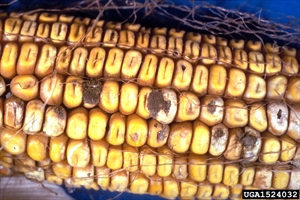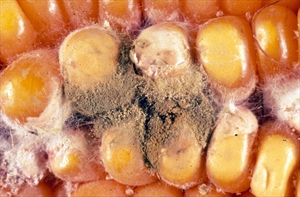- Worldwide distribution. In warm temperate and tropical countries. On many hosts, growing on dead organic matter, both plant and animal. Important as a post-harvest mould of maize, peanut and copra. An important disease, because of its aflatoxin causing severe diseases in livestock and humans.
- Worse: (i) moisture stress >20 days before harvest; (ii) crop is over-mature; (iii) there is insect damage; (iv) moisture content >10%, and stored at high humidity.
- Cultural control: spacing (30 plants/m2); adequate nutrition; avoid end-of-season drought (if possible irrigate); for peanut - before or at harvest: (i) remove dead plants; (ii) check pod colours for correct time (they should have turned pink); (iii) invert plants after harvest and dry for 3-5 days; dry to 8%; for maize - dry to 13-15%; for copra - dry to 5-7% (until it is brittle and breaks easily); for all crops - new bags, and airy, dry, insect-proof store. Rotate crops, leaving a 3-4-year interval between crops of maize or peanuts planted on the same land.
- Chemical control: seed – mancozeb; control insects during growth of the crop, and during storage.







